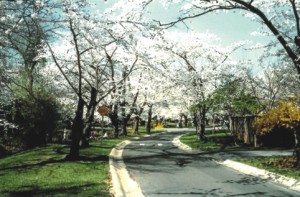|
Musings


Azizul Jalil
“Break open
A cherry tree
And there are no flowers,
But the spring breeze
Brings forth myriad blossoms.”
Ikkyu Sojun, 1394-1481
 The first fortnight of April in Washington is one of its finest times. The clock has been moved forward one hour in late March in an annual ritual, the days are longer and brighter, and spring is in the air. The crocuses, daffodils and anemones have already shown their heads, painting the yards in houses with a subtle and subdued blend of yellow, blue and white. These have been followed by large and bushy forsythia plants, whose leaves are like flowers of bright and joyous yellow colour. The first fortnight of April in Washington is one of its finest times. The clock has been moved forward one hour in late March in an annual ritual, the days are longer and brighter, and spring is in the air. The crocuses, daffodils and anemones have already shown their heads, painting the yards in houses with a subtle and subdued blend of yellow, blue and white. These have been followed by large and bushy forsythia plants, whose leaves are like flowers of bright and joyous yellow colour.
Then suddenly the cherry and pear trees present themselves adorned with charming flowers, usually in their full splendour in the early days of April. The cherry blossom represents love with a graceful warning about the likely fading of that gentle emotion as well. I have recently read that in Japan, one of the most famous folk anthems, “Sakura,” describes the blossoms as looking like “the mist, or else the clouds” that spread across “the expanse of the spring sky.” On the roadside and in people's yards at this time in Bethesda, one marvels at the mostly creamy white cherry and pear blossoms, some pink cherries and cherry magnolias with their interesting and sturdier pink and maroon-coloured flowers. I also see a variety of cherry trees called the weeping cherry. Light pink in colour, they grow fairly tall but its thin limbs bend over as if in distress. To me, however, these plants appear to be modestly curtsying to the admiring passers by. The cherries are quite delicate and drop petals all over the road after even a mild gust of wind. Naturally, these have a short and enchanting blooming period.
On a sunny day when the cherries are at their peak, one can enjoy the beauty of springtime by driving or walking around the Tidal Basin in Washington DC. It is such a spectacular sight that possibly nothing can fully prepare one for the vision of the Tidal Basin in full living glory. A visit to Kenwood in Bethesda is also most rewarding-- hundreds of cherry trees line the narrow streets and hug each other at the top, providing a floral arch, white or cream in colour. At these places, often the sky is hidden by the flowers but the cherries, appearing like clouds, seem to float effortlessly in the air. The scene provides such a feeling of nirvana that at that moment all the world's problems pale into insignificance. One would like the experience to continue forever and while reluctantly leaving the place, would sadly look back at nature's gift of beauty and tranquility, as well as its fragility.
About a million tourists visit Washington at this congenial time weather wise, from all parts of USA and from Canada and abroad to watch the wonderful cherry trees and the parades and festivals. When and how did it all begin? Flowering cherry tree is not a native plant. In 1912, the Mayor of Tokyo, Yukio Ozaki sent 3000 Japanese cherry trees (single-flowering variety) to the people of Washington D.C. as a token of friendship. This unique horticultural gift was received by President Taft's wife, Helen Taft and artistically planted around the oval-shaped tidal basin near the Jefferson Memorial and on the sides of many roads and parks. Again, in 1938, the city of Tokyo presented to the US government a large number of double-blossom Japanese cherry trees. These were planted in the park near the Haines Point, to the south of the Tidal Basin. The entire city comes alive when the trees blossom with delicate shades of cream and pink. This year, the city is celebrating the 95th cherry blossom festival from March 31 to April 15. To commemorate the occasion, Mayor Ozaki's 95year-old daughter, Yukika Sohma, who was born the year of the gift, has traveled to Washington. She and Helen Taft's granddaughter, Manning Hunter ceremonially planted cherry trees in the garden of a hotel looking out over the Tidal Basin.
I will conclude with an interesting anecdote. After the bombing of Pearl Harbour by the Japanese during World War II, some of the Japanese cherry trees at the Tidal Basin were cut down at night and others were renamed “Oriental cherries.” Five years after the war ended, Ozaki visited Washington and recited a self-composed poem quoted below, in which he praised the beauty of the cherry blossoms but hinted at the fragility of nature and human relations:
“Am I awake or do I dream,
So generous the welcome here,
Are these attentions what they seem,
Or shadows that will disappear?”
Azizul Jalil writes from Washington.
Copyright (R) thedailystar.net 2007 |
